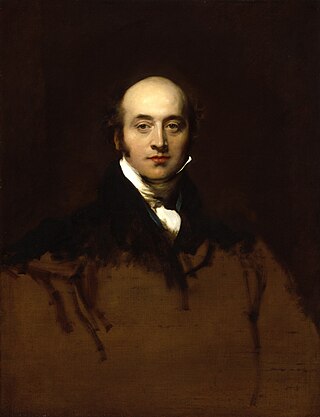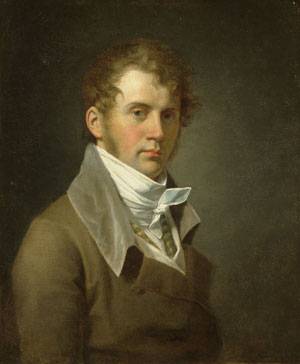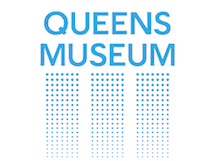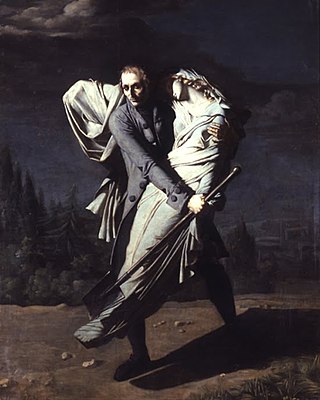
Sir Thomas Lawrence was an English portrait painter and the fourth president of the Royal Academy. A child prodigy, he was born in Bristol and began drawing in Devizes, where his father was an innkeeper at the Bear Hotel in the Market Square. At age ten, having moved to Bath, he was supporting his family with his pastel portraits. At 18, he went to London and soon established his reputation as a portrait painter in oils, receiving his first royal commission, a portrait of Queen Charlotte, in 1789. He stayed at the top of his profession until his death, aged 60, in 1830.

John Sell Cotman was an English marine and landscape painter, etcher, illustrator, and a leading member of the Norwich School of painters.

William Powell Frith was an English painter specialising in genre subjects and panoramic narrative works of life in the Victorian era. He was elected to the Royal Academy in 1853, presenting The Sleeping Model as his Diploma work. He has been described as the "greatest British painter of the social scene since Hogarth".
A cyclorama is a panoramic image on the inside of a cylindrical platform, designed to give viewers standing in the middle of the cylinder a 360° view, and also a building designed to show a panoramic image. The intended effect is to make viewers, surrounded by the panoramic image, feel as if they were standing in the midst of the place depicted in the image.

John Vanderlyn was an American neoclassicist painter.

Roger Fenton was a British photographer, noted as one of the first war photographers.

The Queens Museum, formerly the Queens Museum of Art, is an art museum and educational center located in Flushing Meadows–Corona Park in the borough of Queens in New York City, United States. The museum was founded in 1972, and has among its permanent exhibitions, the Panorama of the City of New York, a room-sized scale model of the five boroughs originally built for the 1964 New York World's Fair, and repeatedly updated since then. It also has a large archive of artifacts from both the 1939 and 1964 World's Fairs, a selection of which is on display.

James Stark was an English landscape painter. A leading member of the Norwich School of painters, he was elected vice-president of the Norwich Society of Artists in 1828 and became their president in 1829. He had wealthy patrons and was consistently praised by the Norfolk press for his successful London career.

George Vincent was an English landscape painter who produced watercolours, etchings and oil paintings. He is considered by art historians to be one of the most talented of the Norwich School of painters, a group of artists connected by location and personal and professional relationships, who were mainly inspired by the Norfolk countryside. Vincent's work was founded on the Dutch school of landscape painting as well as the style of John Crome, also of the Norwich School. The school's reputation outside East Anglia in the 1820s was based largely upon the works of Vincent and his friend James Stark.

The Egyptian Hall in Piccadilly, London, was an exhibition hall built in the ancient Egyptian style in 1812, to the designs of Peter Frederick Robinson. The Hall was a considerable success, with exhibitions of artwork and of Napoleonic era relics. The hall was later used for popular entertainments and lectures, and developed an association with magic and spiritualism, becoming known as "England's Home of Mystery".

Marie-Guillemine Benoist, born Marie-Guillemine Laville-Leroux, was a French neoclassical, historical, and genre painter.
Robert Polidori is a Canadian-American photographer known for his large-scale color images of architecture, urban environments and interiors. His work has been the subject of solo exhibitions at the Metropolitan Museum of Art, Musée d'art contemporain de Montréal, Martin-Gropius-Bau museum (Berlin), and Instituto Moreira Salles. His photographs are also included in the collections of the Museum of Modern Art, New Orleans Museum of Art, J. Paul Getty Museum, Victoria & Albert Museum (London), Château de Versailles, Centre Pompidou (Paris), and Bibliothèque Nationale (Paris), as well as many private collections.

William Marlow was an English landscape and marine painter and etcher.
Daniel Beltrá is a Spanish photographer and artist who makes work about human impact on the environment.

The Sydney punchbowls, made in China during the Jiaqing Emperor's reign (1796–1820) over the mid-Qing dynasty, are the only two known examples of Chinese export porcelain hand painted with Sydney scenes and dating from the Macquarie era. The bowls were procured in Canton about three decades after the First Fleet's arrival at Port Jackson where the British settlement at Sydney Cove was established in 1788. They also represent the trading between Australia and China via India at the time. Even though decorated punchbowls were prestigious items used for drinking punch at social gatherings during the 18th and 19th centuries, it is not known who originally commissioned these bowls or what special occasion they were made for.

Hubert Sattler was an Austrian painter who also signed works with the pseudonyms Louis Ritschard, E. Grossen, and Gottfried Stähly-Rychen. He traveled widely and was noted for large and minutely detailed cosmorama paintings of cities, monuments, and landscapes of many countries.
Port-au-Prince Cosmorama was an exhibition of perspective pictures of different places and landmarks in the world, held on March 2, 1834 in Port-au-Prince, Haiti.

The Velaslavasay Panorama is an exhibition hall, theatre and gardens in Los Angeles, California, featuring the only painted, 360-degree panorama created in the United States since the nineteenth century. The Velaslavasay Panorama was originally established by artist Sara Velas in 2000 at the Tswuun-Tswuun Rotunda on Hollywood Boulevard. The museum's name combines Velas' last name with her mother's maiden name, Asay. In 2004, its original venue threatened with demolition, the panorama moved to its present location at the Union Theatre in Historical West Adams.

The Rotunda was a building that stood in City Hall Park in Lower Manhattan, New York City, from 1818 to 1870.

Pierre Antoine Augustin Vafflard was a French painter who specialized in history, genre scenes and portraits. His later paintings are in the Troubadour style.


















